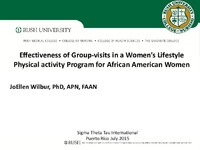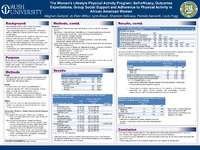| dc.contributor.author | Wilbur, Jo Ellen | en |
| dc.contributor.author | Miller, Arlene Michaels | en |
| dc.contributor.author | Buchholz, Susan | en |
| dc.contributor.author | Braun, Lynne T. | en |
| dc.contributor.author | Dancy, Barbara | en |
| dc.date.accessioned | 2016-03-17T12:58:38Z | |
| dc.date.available | 2016-03-17T12:58:38Z | |
| dc.date.issued | 2016-03-17 | |
| dc.identifier | INRC15D09 | en |
| dc.identifier.uri | http://hdl.handle.net/10755/601903 | |
| dc.description | <p>Research Congress 2015 Theme: Question Locally, Engage Regionally, Apply Globally. Held at the Puerto Rico Convention Center.</p> | en |
| dc.description.abstract | <p>Session presented on Friday, July 24, 2015:</p>
<p><strong>Purpose: </strong>Theoretically-based group physical activity interventions have shown to be the most effective means of increasing physical activity in minority populations. Primary care providers, however, must refer patients to outside community resources where these group interventions have been developed and delivered. The group-visit or centering model, used in some primary care settings to provide health services and group interventions simultaneously, may offer a culturally-relevant, cost-effective alteRNive for delivering physical activity behavior change. In a large RCT, we examined the effects of a physical activity group-visit intervention with three different telephone support conditions (group-visit alone, group-visit + personal telephone calls, group-visit + automated outgoing telephone calls) on African American women's adherence to lifestyle physical activity. The purpose of this paper is, for all three study conditions, to: 1) describe the components of a group-visit physical activity intervention based on Social Cognitive Theory that emphasizes behavioral skills to adopt and maintain an active lifestyle, and 2) examine the effect of attendance at the group-visits (dose) on adherence to lifestyle physical activity.</p>
<p><strong>Methods:</strong> The 12-month Women's Lifestyle Physical Activity Program was developed in collaboration with: a) African American women who attended one of seven focus groups conducted in their communities; b) African American women who participated in one of two follow-up focus groups after participating in a 12-month community-based physical activity intervention; and c) a community advisory board. The Women's Lifestyle Program had 6 African American nurse-led group-visits (lasting 2 hours, delivered every 5 weeks for the first six months, once during the last six months each) with two components: a facilitated group discussion and an individualized physical activity prescription. Women wore a pedometer/accelerometer, entered their steps weekly into an automated telephone response system, and based on an algorithm received feedback and a suggested step goal during the group-visit. Training of the interventionists, using a Group Leader Manual, consisted of a two-day program, monthly meetings with research staff, and yearly retraining. Six study sites (3 community hospitals and 3 community health care centers) were randomly assigned to six different sequences of the intervention conditions to counterbalance the effect of the order of administering the conditions. Eligibility criteria were: African American women, aged 40-65, without cardiovascular symptoms, and without disability related to walking.</p>
<p><strong>Results:</strong> A total of 288 women (18 group-visit cohorts, 95/96 per condition) enrolled. Fifty-nine percent had hypertension and 15% diabetes. Retention was 94% at six months and 90% at 12 months. Over 80% of the women attended > five group-visits with no difference between study conditions. Satisfaction with group visits was high (M=5.93 on a 7 point scale) with no difference between study conditions. There was a significant relationship between group-visit dose and change in accelerometer steps at 24 weeks (r = .17, p = 0.01).</p>
<p><strong>Conclusion:</strong> Overall retention and attendance at the group-visits were high. Attendance at the group-visit boosted change in physical activity. This may be an ideal format for patients with chronic health diseases because primary care providers can care for more than one patient in an appointment and patients can interact with others who share their problems.</p> | en |
| dc.format | Text-based Document | en |
| dc.language.iso | en | en |
| dc.subject | Physical Activity | en |
| dc.subject | African American Women | en |
| dc.title | Effectiveness of group-visits in a women's lifestyle physical activity program for African-American women | en |
| dc.title.alternative | Health promotion in diverse female populations | en |
| dc.type | Presentation | en |
| dc.rights.holder | <p>
All rights reserved by the author(s) and/or publisher(s) listed in this item record unless relinquished in whole or part by a rights notation or a Creative Commons License present in this item record.
</p><p>
All permission requests should be directed accordingly and not to the Sigma Repository.
</p><p>
All submitting authors or publishers have affirmed that when using material in their work where they do not own copyright, they have obtained permission of the copyright holder prior to submission and the rights holder has been acknowledged as necessary.
</p> | en |
| dc.description.note | <p>Items submitted to a conference/event were evaluated/peer-reviewed at the time of abstract submission to the event. No other peer-review was provided prior to submission to the Henderson Repository.</p> | en |
| dc.type.category | Full-text | en |
| dc.evidence.level | N/A | en |
| dc.research.approach | N/A | en |
| dc.contributor.department | Alpha Lambda | en |
| dc.author.details | Jo Ellen Wilbur, RN, FAAN; Arlene Miller, RN, FAAN; Susan Buchholz, RN, ANP-BC, FAANP; Lynne Braun, APN, FAAN; Barbara Dancy, RN | en |
| dc.conference.name | 26th international Nursing Research Congress | en |
| dc.conference.host | Sigma Theta Tau International | en |
| dc.conference.location | San Juan, Puerto Rico | en |
| dc.date.conferenceyear | 2015 | |
| dc.contributor.affiliation | Rush University, Chicago, Illinois, USA | en |
| dc.description.reviewtype | Abstract Review Only: Reviewed by Event Host | en |
| dc.description.acquisition | Proxy-submission | en |





